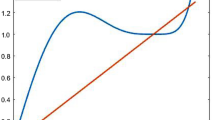Summary
We study the computation of sparse null bases of equilibrium matrices in the context of the force method in structural optimization. Two classes of structural problems are considered. For the class of rigid jointed skeletal structures, we use a partitioning method suggested by Henderson and Maunder to partition the problem into a set of independent null basis computations. For the class of structures represented by a continuum, we compute a sizable fraction of the null vectors in a basis from a consideration of the finite element formulation and the bipartite graph of the equilibrium matrix. The remaining null vectors are computed by the triangular algorithm in [6]. The new algorithms find sparser bases than the triangular algorithm and are also faster.
Similar content being viewed by others
References
Berry, M.W., Heath, M.T., Kaneko, I., Lawo, M., Plemmons, R.J., Ward, R.C.: An algorithm to compute a sparse basis of the null space. Numer. Math.47, 483–504 (1985)
Berry, M.W., Plemmons, R.J.: Computing a banded basis of the null space on the Denelcor HEP multiprocessor. Proc. AMS/SIAM Summer Conference on Linear Algebra in Systems Theory, AMS Series on Contemp. Math. 1985
Burkhardt, J., Hall, C., Porsching, T.: The dual variable method for the solution of compressible fluid flow problems. SIAM J. Algebraic Discrete Methods7, 476–483 (1986)
Cassell, A.C., Henderson, J.C. de C., Kaveh, A.: Cycle bases for the flexibility analyses of structures. Int. J. Numer. Methods Eng.8, 521–528 (1974)
Coleman, T.F., Pothen, A.: The null space problem I: complexity. SIAM J. Algebraic Discrete Methods7, 527–537 (1986)
Coleman, T.F., Pothen, A.: The null space problem II: algorithms. SIAM J. Algebraic Discrete Methods8, 544–563 (1987)
Deo, N., Prabhu, G.M., Krishnamoorthy, M.S.: Algorithms for generating fundamental cycles in a graph. ACM Trans. Math. Software8, 26–42 (1982)
Gero, J.S.: Design optimization. 1st Ed. New York: Academic Press 1985
Gilbert, J.R., Heath, M.T.: Computing a sparse basis for the null space. SIAM J. Algebraic Discrete Methods8, 446–459 (1987)
Heath, M.T., Plemmons, R.J., Ward, R.C.: Sparse orthogonal schemes for structural optimization using the force method. SIAM J. Sci. Stat. Comput.5, 514–532 (1984)
Henderson, J.C. de C., Maunder, E.A.W.: A problem in applied topology: on the selection of cycles for the flexibility analysis of skeletal structures. J. Inst. Math. Appl.5, 254–269 (1969)
Horton, J.D.: A polynomial time algorithm to find the shortest cycle basis of a graph. SIAM J. Comput.16, 358–366 (1987)
Kaveh, A.: A combinatorial optimization problem; optimal generalized cycle bases, Comput. Methods Appl. Mech. Eng.,20, 39–51 (1979)
Pothen, A.: Sparse null bases and marriage theorems. Ph.D. Thesis, Cornell Univ., Ithaca. New York 1984
Topcu, A.: A contribution to the systematic analysis of finite element structures through the force method. Ph.D. Thesis, Univ. of Essen, Germany, 1979 (in German)
Author information
Authors and Affiliations
Additional information
This research was partially supported by NSF grant CCR-8701723 and AFOSR grant 88-0161
Rights and permissions
About this article
Cite this article
Pothen, A. Sparse null basis computations in structural optimization. Numer. Math. 55, 501–519 (1989). https://doi.org/10.1007/BF01398913
Received:
Issue Date:
DOI: https://doi.org/10.1007/BF01398913




